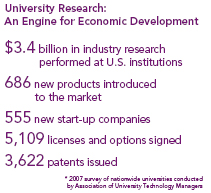|
Putting Innovation to Work: The ABCs of Tech Transfer
Continued...
Unlike industry, where transfer often takes place with the sale of an intellectual property asset, universities most often accomplish the transfer through the option or licensing process. OTT helps faculty, such as those in the college, with the evaluation of discoveries for commercial potential; protects IP through patenting, copyrights, trademarks and trade secrets; markets technologies; develops partners for commercialization and collaborative research; and commercializes IP through licensing and start-up companies, while protecting the university and inventors.
“Our office has done a lot of training across campus to ensure faculty members understand the disclosure and patent process,” explains Weete. “In the rush to publish findings, it is easy to overlook the impact that this can have on their ability to protect related IP.”
 Filing a disclosure form with the OTT office is a first step. The second – filing for a provisional patent – protects the intellectual property before it is shared publicly. This filing gives faculty and OTT time to evaluate the technology and to determine if a full patent application should be filed. Filing a disclosure form with the OTT office is a first step. The second – filing for a provisional patent – protects the intellectual property before it is shared publicly. This filing gives faculty and OTT time to evaluate the technology and to determine if a full patent application should be filed.
“We help the faculty member ensure that the IP meets the criteria for patentability, and, if it does, begin to evaluate its marketability by identifying potential partners,” says Weete. “If after a thorough check, the technology still looks promising, OTT personnel will help faculty navigate the patent process, working with the inventor to identify a potential partner to begin the development and commercialization phases of the process.”
Once the IP is protected, the invention can be brought to market. This three-tier process involves the financing of the start-up process, translation of the invention into a commercial product and marketing of that product.
While some technologies that come to OTT can be turned into products relatively quickly, others are promising but need additional development. When this occurs, OTT may work with an interested party to help them secure necessary funding – possibly through a small business innovation research grant or other vehicle, such as an angel investor who provides early-stage research and development funding for small technology companies.
“Time to market typically averages seven years,” explains Brian Wright, an associate director for commercialization in OTT. “The process from this point on is as variable as the list of technologies. In some cases, a partner needs to be identified and in other cases faculty already have a relationship with an interested party that wishes to license or form a start-up company.”
Whatever the steps in the transfer process, the staff in Auburn’s OTT ensures that the appropriate agreements are executed in order to protect the university and the inventors through intellectual property, collaborative research, material transfer and confidentiality agreements.
Weete cites a number of engineering success stories that range from a carpet recycling technology to next generation network security integrated into high-performance protocols to address new and expanding communications platforms and related Internet security threats. With implementation of the new business plan, revenue from these and other projects is beginning to flow into the university to the tune of $500,000 to $750,000 annually. Weete expects to see steady growth in revenue over the next few years.
“Engineering routinely accounts for just under half of Auburn’s research expenditures,” says Dean Larry Benefield. “Our faculty members generate a lot of IP and work closely with the Office of Technology Transfer to begin the commercialization process that can result in job creation. University discoveries will play an increasingly important role in the growth of the knowledge-based economy and in ensuring the vitality of Alabama and the nation.”
 << Previous
|
 Filing a disclosure form with the OTT office is a first step. The second – filing for a provisional patent – protects the intellectual property before it is shared publicly. This filing gives faculty and OTT time to evaluate the technology and to determine if a full patent application should be filed.
Filing a disclosure form with the OTT office is a first step. The second – filing for a provisional patent – protects the intellectual property before it is shared publicly. This filing gives faculty and OTT time to evaluate the technology and to determine if a full patent application should be filed. 

